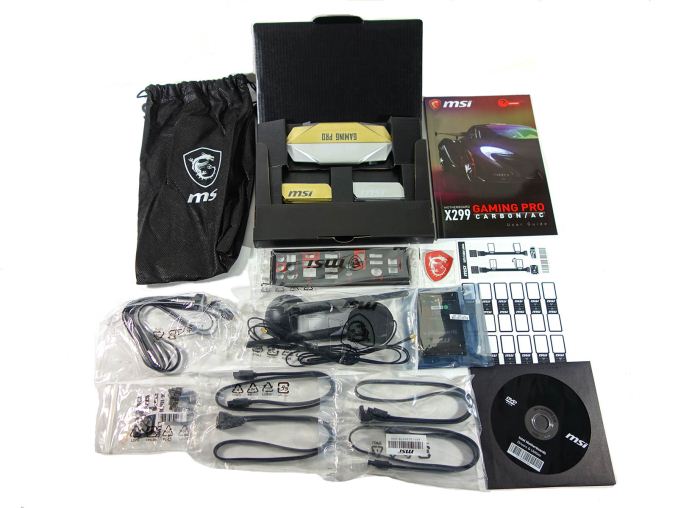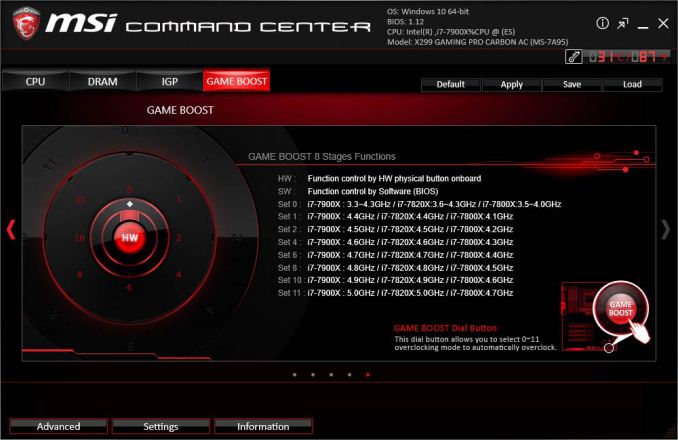The MSI X299 Gaming Pro Carbon AC Motherboard Review
by Patrick MacMillan on September 21, 2017 9:00 AM ESTBoard Features
While the X299 Gaming Pro Carbon is packed with many of the same features that we have seen on previous MSI models - like PCIe slot and memory slot reinforcement, M.2 Shield, Mystic Light RGB LED lighting - MSI has unveiled some new ideas like user-replaceable heatsink covers and mounting points for 3D printed accessories. MSI has also included two sets of gold and silver colored heatsink covers, so you can swap out the black faux carbon fiber inserts that are found on the rear I/O shroud, the MOSFET heatsink, the chipset heatsink, or the shroud covering the audio section.
| MSI X299 Gaming Pro Carbon AC | |
| Warranty Period | 3 Years |
| Product Page | Link |
| Price | Amazon US |
| Size | ATX |
| CPU Interface | LGA2066 |
| Chipset | Intel X299 |
| Memory Slots (DDR4) | Eight DDR4 Supporting 128GB Quad Channel Up to 4266+ MHz |
| Network Connectivity | Intel I219-V |
| Onboard Audio | Realtek ALC1220 |
| PCIe Slots for Graphics (from CPU) | 4 x PCIe 3.0 - x16 - x16/x16 - x16/x16/x8 With 44-lane CPU. - x16 - x16/x8 - x8/x8/x8 With 28-lane CPU. - x8 - x8/x8 With 16-lane CPU. |
| PCIe Slots for Other (from PCH) | 2 x PCIe 3.0 x1 1 x PCIe 3.0 x4 |
| Onboard SATA | Eight, RAID 0/1/5/10 |
| Onboard M.2 | 2 x PCIe 3.0 x4 NVMe or SATA, RAID 0/1 |
| Onboard U.2 | 1 x PCIe 3.0 x4 NVMe |
| USB 3.1 Gen2 | 1 x Type-A 1 x Type-C 1 x Type-C Header 2 x ASMedia ASM3142 Controller |
| USB 3.0 | 3 x Rear Panel (ASMedia ASM1074) 1 x Rear Panel (Chipset) 4 x Via Headers (Chipset) |
| USB 2.0 | 3 x Rear Panel (Chipset) 4 x Via Headers (Chipset) |
| Power Connectors | 1 x 24-pin ATX 1 x 8-pin CPU 1 x 4-pin CPU |
| Fan Headers | 1 x CPU (4-pin) 1 x Water Pump (4-pin) 4 x CHA/SYS (4-pin) |
| IO Panel | Clear CMOS & BIOS FLASHBACK+ Buttons 1 x Combination PS/2 3 x USB 2.0 (Chipset) 2 x Wi-Fi Antenna Jacks (Intel) 4 x USB 3.0 (ASMedia) 1 x Network RJ-45 (Intel) 1 x USB 3.1 Gen2 Type-A (ASMedia) 1 x USB 3.1 Gen2 Type-C (ASMedia) 5 x Audio Jacks + 1 x S/PDIF |
| Other Features | TPM Module Connector Clear CMOS Jumper Slow Mode Jumper GAME BOOST knob Power/Reset Buttons Multi-BIOS Switch RGB LED Connector Front Panel Header Virtual RAID on CPU connector (VRAID1) Front Audio Header |
Since the X299 chipset is so similar to the Z270, it should come as no surprise that the LGA2066 platform doesn't offer anything drastically new on the connectivity front. Support for VROC is the only exception, though that requires a Skylake-X processor and a pricey hardware key from Intel if you want to unlock the more complex functionality. Frankly, given that the Realtek ALC1220 and Intel I219-V are known entities, what interests us the most is MSI's use of the ASMedia ASM3142 USB 3.1 Gen2 controller - two of them, in fact - for the rear I/O ports and the internal USB Type-C port header. Another interesting addition is the Intel Dual Band Wireless-AC 8265 module that occupies the onboard M.2 Key-E slot. This 802.11ac Wi-Fi/Bluetooth 4.2 module is not strictly new, but it has not found its way to any previous motherboard generation. However, since it's still just a basic dual-band 867Mbps solution it is hard to get excited when some competing X299 motherboards are offering cutting-edge 802.11ad (WiGig) wireless connectivity (albeit at a higher price point).
In The Box
When you open this motherboard's packaging, you are greeted by two separate sections. The top half holds the motherboard in an anti-static bag, while the bottom half contains the numerous bundled accessories, software DVD and documentation.
When you lay out the accessories, you get the following:
In no particular order, the bundled accessories consists of a manual, quick installation guide, SATA cable labels, software/driver DVD, MSI Gaming case badge, rear I/O cover, SLI HB bridge, four SATA cables, Two Wi-Fi antennas, RGB LED Y-splitter cable, two sets of heatsink replacement covers, and twelve 3D X-Mounting standoffs. Overall, it's a pretty decent assortment of accessories, though we would have liked another one or two sets of SATA cables.
Overclocking
Since this platform launch was more than a little rushed, at least with respect to last minute foibles, we didn't really had enough hands-on time to manually determine the overclocking limits of our 10-core Core i9-7900X processor. Having said that, this was the perfect opportunity to probe the automatic overclocking capabilities of this X299 Gaming Pro Carbon AC. With a total of 8 Game Boost levels available, in either the BIOS or the Command Center utility, it really was just a matter of selecting our desired frequency target and within seconds the overclock preset was applied.
In our testing, Level 1 merely set the standard Turbo frequency - 4.3GHz- across all cores, while the aptly named Level 11 pushed the core frequency to a stratospheric 5.0Ghz at 1.425V. While we could load Windows at Level 11, stability was essentially nonexistent.
Dialing things back a little to Level 10 saw our processor running at 4.9GHz at 1.40V. While we could toil around Windows, and it would pass even pass some of our lighter benchmarks, loading up all the cores in any stress test instantly resulted in a system crash. This was clearly due to hitting thermal limits, since using either a Corsair Hydro H110i GT or an surprisingly capable Prolimatech Mega Shadow heatsink, we consistently saw temperatures climb into the dreaded mid-to-upper 90C range. We strongly suspect that every conventional heatsink or all-in-on liquid cooler will be overwhelmed by the amount of heat a i9-7900X can radiate at anything approaching 1.40Vcore. If you have an air conditioning unit nearby, we suggest that you crank that to Level 10.
Dialing things back even further, Level 8 set the frequency to 4.8GHz at 1.375V, which resulted in a small but appreciable decrease in heat output. We were able to run OCCT for a moment, but once again temperatures would skyrocket until the inevitable system crash. If we can manually get the Vcore down to the 1.30-1.25V, and massage the other system settings, we strongly suspect that 4.8GHz will be a realistic target our particular chip with the right cooling.
Ultimately, we settled on Level 2, which meant 4.5Ghz at 1.30V. At that level, we could run OCCT for as long as we were willing to ignore the still redlined CPU core temperatures. Obviously, we did not bother enabling the "AVX Capable Linpack" option since that would once again crash the system.
Overall, we can't fault the MSI X299 Gaming Pro Carbon AC for anything since the processor - or more accurately processor cooling - is the bottleneck at the moment. The Game Boost feature has a been a reliable overclocking tool for a few generations now, and that appears to also apply to this new platform.












24 Comments
View All Comments
Dr. Swag - Thursday, September 21, 2017 - link
Typo on the first page, under the skylake x CPU table. It should say the gaming pro carbon not the gaming i9 :)nevcairiel - Thursday, September 21, 2017 - link
I've had the X299 Gaming Pro Carbon with a 7900X since early July when the X299 platform launched, and I'm quite happy with it. The latest BIOS update has resolved the last small annoyance I had with it, as well.Juliebattery - Saturday, September 23, 2017 - link
Have you find the correct battery for X299 in good quality and reasonable price?vgray35@hotmail.com - Thursday, September 21, 2017 - link
A PCIe 3.0 x4 interface for the DMI 3.0 link means the chipset's 24 lanes of PCIe 3.0 are being pushed though this narrow x4 link, which is really a joke as this is not a PCIe switch interface, so to think 24 lanes squished over a x4 lane DMI does not limit bandwidth is pie in the sky. The fiasco of thermal paste in the CPU causing heat problems is also a joke, so why would anybody consider the x299 platform is a viable HEDT worth considering with such poor cooling performance. VRM power delivery.using multi-phase Buck converters is pushing it beyond its realistic capabilities with 88% full load efficiency, and certainly cannot be heralded as a viable HEDT platform power supply with currents exceeding 150 Amps. All these factors combined yield a less than ideal product right out of the gate, whose cost is sky rocketing because of expensive power delivery solution, and outlandish Intel prices. To be frank, the PC industry has lost its marbles.TEAMSWITCHER - Thursday, September 21, 2017 - link
So ... you've analyzed the thermal paste yourself? Did a complete chemical work up? Used an alternative thermal compound and got 6 GHZ on air?DanNeely - Thursday, September 21, 2017 - link
Please don't feed the troll again. He created an ~40 message flamewar on the recent x399 article over his pet favorite power topology.MajGenRelativity - Thursday, September 21, 2017 - link
While I agree with Dan on feeding the troll, it is widely known that thermal paste is not as thermally conductive as solder. I refuse to comment on the rest of vgray's comment.BrokenCrayons - Thursday, September 21, 2017 - link
I don't see a problem with thermal paste between the CPU and the IHS as long as you're not pushing the CPU beyond its OEM specifications. Overclocking is done at your own risk and I see no reason why Intel should get taken to task over not supporting a person that by all rights should know they're trying to operate outside of the envelope to eek out a slightly higher benchmark score while reaping little to no real world benefit for all their effort and expenses.MajGenRelativity - Thursday, September 21, 2017 - link
Because Intel downgraded their performance that way. It also affects regular users, because lower thermal conductivity makes the fans run harder even when not overclocking. Furthermore, even without overclocking, Skylake-X can consume quite a bit of power, as mentioned in this article.MajGenRelativity - Thursday, September 21, 2017 - link
To break out my second response, overclocking isn't just for the benchmarks. In CPU limited applications, overclocking will increase your performance. A good example would be financial traders, but there are many other CPU limited applications.